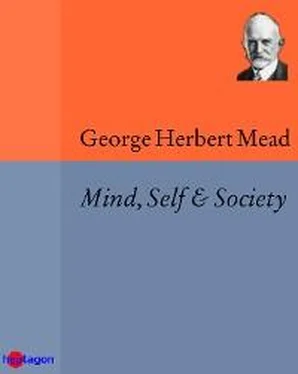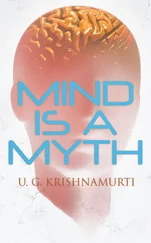George Herbert Mead - Mind, Self & Society
Здесь есть возможность читать онлайн «George Herbert Mead - Mind, Self & Society» — ознакомительный отрывок электронной книги совершенно бесплатно, а после прочтения отрывка купить полную версию. В некоторых случаях можно слушать аудио, скачать через торрент в формате fb2 и присутствует краткое содержание. Жанр: unrecognised, на английском языке. Описание произведения, (предисловие) а так же отзывы посетителей доступны на портале библиотеки ЛибКат.
- Название:Mind, Self & Society
- Автор:
- Жанр:
- Год:неизвестен
- ISBN:нет данных
- Рейтинг книги:3 / 5. Голосов: 1
-
Избранное:Добавить в избранное
- Отзывы:
-
Ваша оценка:
- 60
- 1
- 2
- 3
- 4
- 5
Mind, Self & Society: краткое содержание, описание и аннотация
Предлагаем к чтению аннотацию, описание, краткое содержание или предисловие (зависит от того, что написал сам автор книги «Mind, Self & Society»). Если вы не нашли необходимую информацию о книге — напишите в комментариях, мы постараемся отыскать её.
Mind, Self & Society — читать онлайн ознакомительный отрывок
Ниже представлен текст книги, разбитый по страницам. Система сохранения места последней прочитанной страницы, позволяет с удобством читать онлайн бесплатно книгу «Mind, Self & Society», без необходимости каждый раз заново искать на чём Вы остановились. Поставьте закладку, и сможете в любой момент перейти на страницу, на которой закончили чтение.
Интервал:
Закладка:
Contrary to Darwin, however, we find no evidence for the prior existence of consciousness as something which brings about behavior on the part of one organism that is of such a sort as to call forth an adjustive response on the part of another organism, without itself being dependent on such behavior. We are rather forced to conclude that consciousness is an emergent from such behavior; that so far from being a precondition of the social act, the social act is the precondition of it. The mechanism of the social act can be traced out without introducing into it the conception of consciousness as a separable element within that act; hence the social act, in its more elementary stages or forms, is possible without, or apart from, some form of consciousness.
4. RISE OF PARALLELISM IN PSYCHOLOGY
The psychology which stresses parallelism has to be distinguished from the psychology which regards certain states of consciousness as existing in the mind of the individual, and succeeding each other in accordance with their own laws of association. The whole doctrine of the psychology which follows Hume was predominantly associationistic. Given certain states of consciousness they were supposed to be held together by other similar elements. Among these elements were those of pleasure and pain. Connected with this atomism of associated conscious states was a psychology of action grounded on the association of pleasure and pain with certain other sensations and experiences. The doctrine of association was the dominant psychological doctrine; it dealt with static rather than dynamic experience.
The pushing of the psychological side further and further into the central nervous system revealed that there were whole series of experiences which might be called sensations and yet were very different from those which could be regarded as static, such as sound, odor, taste, and color. Association belonged to this static world. It was increasingly recognized that there was a large part of our experience which was dynamic. The form of actual doing was present in some of the sensations which answered to the innervation of sensory nerves. There was also the study of those tracts which went down to the viscera, and these certainly were aligned with the emotional experiences. The whole process of the circulation of the blood had been opened up, and the action which involved the sudden change of the circulation of the blood. Fear, hostility, anger, which called for sudden movement, or terror, which deprived the individual of the ability to move, reflected themselves in the visceral conditions; and also had their sensory aspects connected with the central nervous system. There was, then, a type of experience which did not fall into place in a static world. Wilhelm Wundt approached his problem from the standpoint of this sort of physiology which offered a clew by means of which one could follow out these various dynamic experiences into the mechanism of the organism itself.
The treatment which had been given to the central nervous system and its motor and sensory nerves had been that of bringing a nerve current to a central nervous system which was then in turn responsible for a sensation that happened in »consciousness«. To get a complete statement of what we call the act one had to follow up the sensory side and then follow out the motor results that took place because of what happened in consciousness. The physiology to which I have referred in a certain sense separated itself from the field of consciousness. It was difficult to carry over such a mechanism as this into the lower animals. That, at least, took the psychologist out of the field of animal experience. Darwin regarded the animal as that out of which human conduct evolves, as well as the human form, and if this is true then it must be that in some sense consciousness evolves.
The resulting approach is from the point of view of conduct itself, and here the principle of parallelism is brought in. What takes place in consciousness runs parallel with what takes place in the central nervous system. It is necessary to study the content of the form as physiological and also as psychological. The center of consciousness, within which is registered that which affects the sensory nerves and out of which springs the conduct due to sensation and memory images, is to be taken out of the physiological mechanism; and yet one must find a parallel in what takes place in the nervous system for what the physiologist had placed in consciousness as such. What I have referred to in the matter of the emotions seemed to present a physiological counterpart for what takes place in consciousness, a field that seemed to belong peculiarly to the mental side of life. Hate, love, anger – these are seemingly states of mind. How could they be stated in physiological terms? The study of the acts themselves from an evolutionary standpoint, and also the study of the changes that take place in the organism itself when it is under the influence of what we call an emotion, present analogues to these emotional states. One could find something there that definitely answered to the emotions.
The further development of this lead occurred in James's theory of the emotions. Because we run away when we are afraid, and strike when we are angry, we can find something in the physiological organism that answers to fear and to anger. It is an attitude in the organism which answers to these emotional states, especially these visceral conditions to which I have referred, and the sudden changes in the circulation which are found associated with emotions. It becomes possible to relate the psychical conditions with physiological ones. The result was that one could make a much more complete statement of the conduct of the individual in physiological terms, could find a parallel for that which is stated in terms of consciousness in the mechanism of the body and in the operation of that mechanism. Such a psychology was called, naturally enough, a physiological psychology. It was a statement in terms of what went on in the organism of the content with which the psychologist had been dealing. What is there in the act of the animal which answers to these different so-called psychological categories? What is there that answers to the sensations, to the motor responses? When these questions were answered physiologically, they, of course, involved mechanisms located inside of the act, for all that takes place in the body is action. It may be delayed action, but there is nothing there that is itself simply a state, a physiological state that could be compared with a static state. We come then to the sensations and undertake to state them in terms of complete reflex action. We deal with the sensation from the standpoint of the stimulus, and when we come to deal with the various emotional states we deal with them in terms of the preparation for action and the act itself as it is going on. That is, it becomes now essential to relate a set of psychical states with the different phases of the act. Parallelism, then, is an attempt to find analogues between action and experienced contents.
The inevitable result of this analysis was to carry psychology from a static to a dynamic form. It was not simply a question of relating what was found in introspection with what is found in the organism; it became a question of relating together those things which were found in introspection in the dynamic way in which the physiological elements were related to the life of the organism. Psychology became in turn associational, motor, functional, and finally behavioristic.
The historical transformation of psychology was a process which took place gradually. Consciousness was something which could not be simply dispensed with. In early psychology there was a crude attempt to account for consciousness as a certain secretion in the brain, but this was only a ridiculous phase of the transformation. Consciousness was something that was there, but it was something that could be brought into closer and closer relationship with what went on in the body. What went on there had a certain definite order. Everything that took place in the body was part of an act. The earlier conception of the central nervous system assumed that one could locate certain faculties of the mind in certain parts of the brain, but a study of the central nervous system did not reveal any such correlation. It became evident that there were nothing but paths in the central nervous system. The cells of the brain were seen to be parts of the nervous paths provided with material for carrying on the system, but nothing was found there to carry on the preservation of an idea as such. There was nothing in the central nervous system which would enable one to locate a tract given over to abstractions. There was a time when the frontal lobe was regarded as the locus of thought-processes – but the frontal lobe also represents nothing but paths. The paths make very complicated conduct possible, they complicate the act enormously through the mechanism of the brain; but they do not set up any structure which functionally answers to ideas. So the study of consciousness from the standpoint of the organism inevitably led men to look at consciousness itself from the point of view of action.
Читать дальшеИнтервал:
Закладка:
Похожие книги на «Mind, Self & Society»
Представляем Вашему вниманию похожие книги на «Mind, Self & Society» списком для выбора. Мы отобрали схожую по названию и смыслу литературу в надежде предоставить читателям больше вариантов отыскать новые, интересные, ещё непрочитанные произведения.
Обсуждение, отзывы о книге «Mind, Self & Society» и просто собственные мнения читателей. Оставьте ваши комментарии, напишите, что Вы думаете о произведении, его смысле или главных героях. Укажите что конкретно понравилось, а что нет, и почему Вы так считаете.












